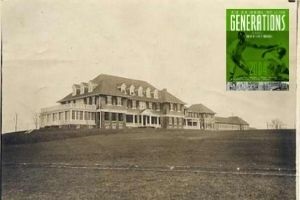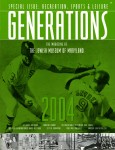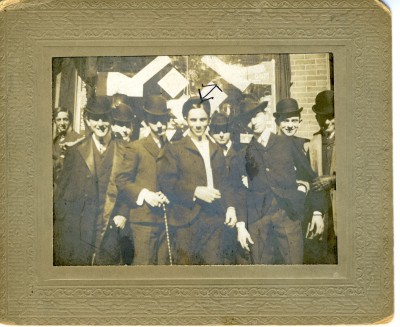A Club of Their Own Part VI

 Article by Dr. Deborah R. Weiner. Originally published in Generations – 2004: Recreation, Sports & Leisure. This particular issue of Generations proved wildly popular and is no longer available for purchase.
Article by Dr. Deborah R. Weiner. Originally published in Generations – 2004: Recreation, Sports & Leisure. This particular issue of Generations proved wildly popular and is no longer available for purchase.
Part VI: The View from a New Millenium
Missed parts 1-5? Start here.
But here we are, 25 years later, and clearly, the clubs have survived. Not all of them, to be sure. At the height of country club popularity in the 1950s, several new Jewish clubs started up in the Baltimore area. Boonie View, Summit, and Chestnut Ridge didn’t really compete with Woodholme and Suburban; rather, they offered a less expensive alternative with “less formality and restrictions,” especially with regard to children. Around the same time, a long-established in-town club, the Mercantile, bought property in the suburbs and turned itself into a country club (sans golf, though). Of the four, only Chestnut Ridge survives today.[1]
It wasn’t cultural values spawned in the 1960s that did these clubs in. In fact, status-consciousness and materialism made a big comeback in the Reagan era. Rather, country clubs have confronted other challenges in recent decades. They face much more competition from an explosion in entertainment and recreation options, from high-end public golf courses, health clubs, and home swimming pools to restaurants, cable television, summer camps, and increasingly diverse vacation opportunities. Meanwhile, even well-to-do families have experienced a financial crunch, with many sending their children to private schools and all confronting skyrocketing college fees. Amidst all these expenses, country clubs have become more of a luxury that ever, one that many people find it possible to forego.[2]
To meet these new challenges, Suburban and Woodholme, as always, have had to adapt. Woodholme “is no longer a social hub,” Paul Goldberg points out, no longer the main gathering place for its members’ social lives. Its general manager, Mitchell Platt, concurs. “There are a lot more things pulling people away from clubs…That’s the challenge to maintaining a club today.” According to Platt, country clubs have to constantly improve, to offer their members services as a level that convinces them it’s still worthwhile to belong Woodholme’s clubhouse underwent a complete renovation in 1993, built a new Olympic-sized pool two years ago, and has begun to emphasize services that previously were not central to its operation. For example, it now aggressively markets itself as a premier place for private parties. But its continued commitment to golf remains “the driving force” in membership recruitment and retention, says Platt (in a nifty, if unintentional, pun).[3]
At Suburban, adaptation has taken a different form. If, as one Suburban member acknowledges, Woodholme now has “a younger, more aggressive membership,” another member asserts that the Suburban Club provides “a home away from home” for a membership that tends to be older and a bit less active. Its excellent dining facilities, convenient location, and quiet atmosphere compare favorably to crowded and noisy restaurants, and many members spend much time there; as one person noted, “We eat there two or three times a week.” Also, Suburban has made accommodations for new members who arrive from other clubs. It received a large contingent from the recently closed Bonnie View – and also attracted new members from a somewhat surprising place a few years ago: Woodholme, where disagreements over land sales and tee-time policies caused some members to resign.[4]
Woodholme members joining Suburban? Apparently it really is a new millennium. Actually, the German-East European split that had marked Baltimore Jewry for decades began to break down, as did so many other social norms, in the post-World War II era. Some say that the Suburban Club began to relent as early as the 1930s, when the Depression forced it to “lower” its membership standards. But most date the change a bit later. Bertha Friedberg believes that attitudes began to change “after Hitler,” when “every Jew felt their Jewish identity more strongly,” and the community “felt more united.” As the “product of a mixed marriage” (her father was Lithuanian and her mother German), she is in a position to know. “I’ve had a foot in both communities,” she observes, and she has been a member of both country clubs. The change didn’t take place overnight: Friedberg as well as other Suburban and Woodholme members describe a gradual thaw that accelerated in the 1960s and 1970, when many Jews of Eastern European descent began to join Suburban. (Notably, this was another period when country clubs needed to take action to keep membership figures up.) Today, the distinction between the “Germans” and the “Russians” “Doesn’t exist anymore,” says Morton Offit, son of a Woodholme founder. “Everything changes.” While some other Suburban members retain a lingering nostalgia for the days when German Jewry reigned over the social scene, they are a decided minority.[5]
Today, members at both clubs are less likely to have roots in the community than in previous eras, making the old divisions even more irrelevant. Nevertheless, a strong sense of family tradition continues to pervade these two venerable Baltimore Jewish institutions. Julius Westheimer notes that his family has belonged to the Suburban Club for more than 100 years, giving him an association with the club since birth – both his and Suburban’s. That’s not a legacy to be taken lightly. Morton Offit echoes his sentiments from the other side of Pikesville. “I guess I’ve been a member of Woodholme all my life…Every time I go out to the club, I wave at my father’s picture,” which hangs on the wall alongside other Woodholme founders.

And what of the future? Again, many people see an uncertain outlook for country clubs. “It’s a dynamic situation,” says Sewell Sugar, who thinks that country clubs may be “on their way out.” As he points out, “My kids won’t go out there.” Their interests run more to travel, hiking, and other sorts of recreational activities that country clubs can’t fulfill. Suburban member E. B. Hirsh agrees. Her grandchildren “don’t think that club life is the way to go” – they keep busy with school, summer camps, and family vacations. Arthur Gutman sees Suburban’s aging membership as “a bad sign.” Says Bertha Friedberg, “Many young people choose not to belong to clubs anymore.” Given all the economic demands on their families, “It’s too expensive.” Plus, she observes, with both parents usually working, lifestyles have changed drastically, leaving the clubs behind.
But the Suburban Club has been around for over a century, and Woodholme for almost 80 years. It’s hard to imagine them disappearing. Most likely, they will adapt – something they are surprisingly good at. True, they won’t be “your grandfather’s country club,” but quite possibly, they will find ways to continue playing a role in Baltimore’s Jewish recreational and social scene.
~The End~
Notes:
[1] Nugent, “Some Things You Always Wanted to Know,” 34; Mercantile Club vertical file, JMM; “Mercantile Country Club Sells Land To Pay Debts,” Jewish Times, October 23, 1987; Lisa Rosato, “Reisterstown Golf Site Dropped,” Owings Mills Times, September 24, 2003. Quote is from Karen Stuhler, “Northwest Baltimore, Ranchleigh & The Bonnie View Country Club: A Historical and Architectural Review” (unpublished paper, Maryland Room vertical files, Enoch Pratt Free Library), 6.
[2] Various interviews.
[3] Glodberg, Platt interviews; “About Our Blub.”
[4] Various interviews; rosato, “Reisterstwon Gold Site Dropped;” David Conn, “A Bad Slice: Attrition, and Possibly Land Purchases, Leaves Woodholme Poorer by About 40 Families,” Jewish Times (from JMM vertical files).
[5] Bertha Friedberg, phone interview with author, December 2004; Offit interview; other interviews.
